The helicopter's blades cut through the air in heavy, monotonous bursts of sound. It's after 7:30 and the sun is already up, but it's still not hot enough to become tiring. The landscape, of dry bushes due to winter, makes the job of Marius, the helicopter pilot, easier. His eyes have detected a white rhinoceros in the middle of the savannah of South Africa's Kruger National Park. He notifies the crew. One of the rangers (park guard) from the helicopter takes a rifle and shoots at the animal. On target the first time. The rhino growls, but the sound is drowned out by the noise of the propellers. He advances a few uncoordinated steps through the bushes as if without understanding what is happening. Suddenly, he collapses. Marius begins to lower the helicopter and lands gently on the ground, raising a wind full of sand and dry grass like straw. When the propeller stops rotating, a team of several rangers with rifle, two veterinarians and Marius himself. They hurriedly run towards the rhino. He is not dead. He is sleeping. They haven't caught him. They are saving his life.
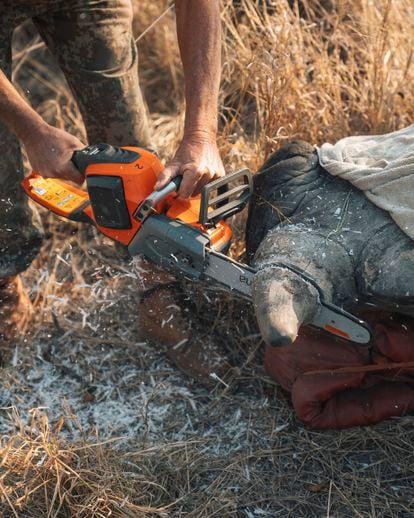
The team works fast. They know that they have little time and the work they have come to do is expensive. The first thing they do is cover his eyes with a towel and tie ropes to immobilize him. Afterwards, they measure the horn and with a device they look behind the ears and along the neck to see if it has a microchip. The rhino does not move, breathes heavily and from time to time growls again. It is a young male specimen, which means that its horn grows at a faster rate than other specimens. In pregnant females, the horn barely grows because all its energy is dedicated to pregnancy.
Suddenly, the growls stop being heard. Marius has a giant electric saw in his hands that he approaches towards the animal's horn. He cuts it by making hundreds of splinters fly onto the ground. He smells like a burnt nail, he has the texture of a fingernail and when you cut him he becomes the same as a fingernail: garbage. Rhinoceros horn has absolutely no miraculous or even beneficial properties, but it is still revered in Asian countries such as China or Vietnam. In those parts of the world, they have been thinking for centuries that horn turned into powder cures everything from hangovers to cancer and, at the same time, having a whole horn from an adult specimen is a sign of economic power. On the black market, the price of rhino horn reaches 60,000 euros per kilogram. More expensive than cocaine.
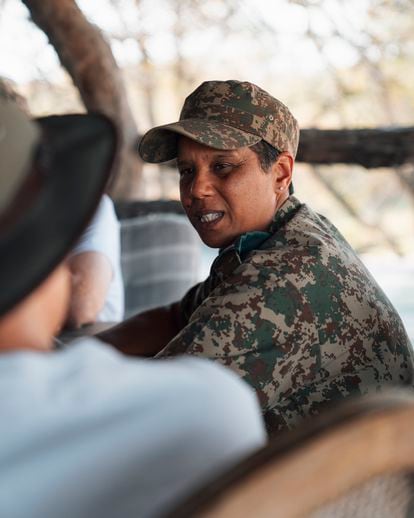
“We have a huge border with Mozambique, much of it open, where poachers enter. Mozambicans are paid by criminal groups by the kilogram, so they tear off the horn even if it is small. Most of these hunters are very poor people,” says Cathy Dreyer, the first female chief of the rangers of the Kruger National Park since its foundation. Dreyer has been dedicated to the protection of rhinos for more than 21 years. He practically his entire working life. He started in a team similar to the one that accompanies Marius in the helicopter but in Kimberley, in the center of South Africa. “I stayed there for 13 years but I got really tired of living in a sleeping bag and a tent because we spent eight months on the road and four at home.” Thus, Dreyer joined the team of the rangers of the Kruger Park and, for two years, she became its boss.
Most days, his day and that of the rest of the rangers consists of getting up at four in the morning and working until the sun sets. The Kruger Park, at 19,000 square kilometers, is almost the same area as Israel. An extensive territory of baobabs and bushes that is difficult to keep under control. “From one end of the park to the other can take a whole day if you go by car,” says Dreyer. The Kruger employs about 2,500 people. Of them, only 386 are rangers. Too few to keep dozens of poachers at bay in such a vast territory. In 2011, the Kruger was home to a population of 10,621 white rhinos. In 2022 there were 2,225 left. In the first six months of 2023 alone, 42 rhinos were killed by poachers in the national park.
“It depends on the rangers of terrain to detect the tracks of the poachers and track them, sometimes, all day long,” explains Dreyer, “we have dogs to sniff out the trail, license plate recognition cameras hidden behind the bushes, night vision goggles and we are training helicopters that they can fly at night. We have improved but so have the poachers. “They are always one step ahead.” On many occasions, this step forward is due to nothing more than help, a tip-off, from within. From among the ranks of their own rangers. “40% of the staff are reportedly involved in poaching,” D
reyer acknowledges.
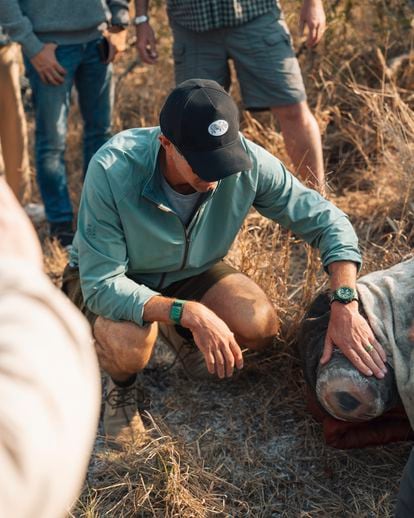
When she took office, she herself fired more than 40 rangers. “We had a ranger regional involved a few years ago,” says Dreyer. He is referring to Rodney Landela. A park worker for 15 years, all of his colleagues saw him as the next boss before Dreyer took over. In 2016, it was those colleagues who trusted him who discovered him fleeing the place where a dead rhinoceros lay. The bullet from his rifle was what had killed him and his bloody shoes left no room for doubt. The torn off horn was found a few meters from the place. “We have a very serious problem with corruption and we are only now beginning to understand how rangers “They end up in those mafia networks,” explains the Kruger boss.
In general, the system is almost always the same: a ranger He has a debt and ends up borrowing money from a loan shark. Loan sharks in South Africa are often involved in poaching and when they find out where their client works, they do not hesitate to blackmail him using his family. For their part, the rangers They know exactly where each animal is, the deployments of their companions and they have weapons and the possibility of removing the horn once the animal has been killed. “The rangers definitely don't get paid enough in the park. A field ranger earns between R10,000 and R12,000 per month. [alrededor de 600 euros]”Dreyer admits. But with poaching you can get good bites into your pocket.
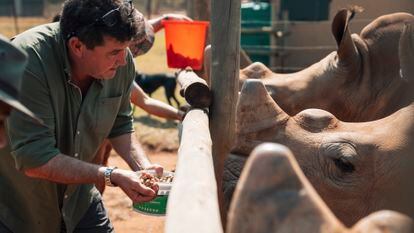
“The people who come here to kill are desperate. These are people who kill because they want to feed their children. “Those who live here don't understand why tourists come to photograph their food,” acknowledges Kevin Pietersen, former cricketer and founder of the SORAI organization, which is dedicated to providing monetary support for conservation work in the Kruger National Park. His organization, with which brands such as Hublot collaborate, which has already released three watches dedicated to the protection of rhinos, has specialized in raising funds that are then allocated to schools to educate local children in protection. of the animal and in monetarily supporting the activities of the rangers. Dehorning a rhino like the one Marius has done, which involves the mobilization of a team of professionals and fuel for a helicopter, costs about 2,000 euros for each animal. An amount of money that the park does not have. On good days, they can dehorn up to 20 rhinos. “Unfortunately, in South Africa we do not have a government that wants to strictly ban hunting,” says Pietersen. In fact, rhino hunting is legal in the country if you have a permit from the Government (there are about 1,000 licenses issued at the moment). The international horn trade is prohibited, but the internal trade is not.
After cutting off the rhino's horn, Marius lets his team work. One of the veterinarians takes a stool sample and five tubes of blood that will later be analyzed in the laboratory. The severed horn rests next to her, on the ground. Its filed beak indicates that this specimen was already dehorned a few months ago. It is soft and heavy, and in the freshly cut part it shows a beige color with a dark gray center that draws the shape of a heart. When all the measurements are finished, they release the rhino who no longer grunts or kicks but immediately stands up. Everything is over. In 18 months, when the horn grows back, everything will start again. That is if the rhino does not suffer the same fate as the 42 specimens that have already been killed by poachers this year. “Many people tell me why don't we shoot and kill the poachers. “I wish we could,” says Dreyer, laughing; No, joking aside, the last thing we want is for a ranger to be accused of murder and end up in prison. If you have to shoot, let it be to immobilize and not to kill.”
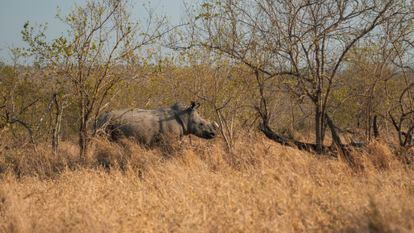
Subscribe to continue reading
Read without limits
_
#Mission #protect #white #rhino